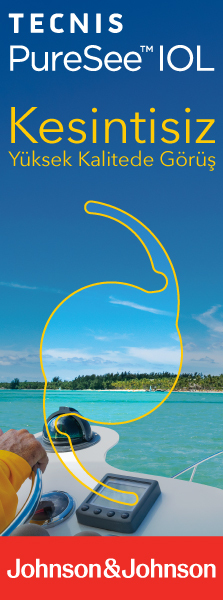TJ-CEO
2009 , Vol 4 , Num 3
Comparison of Visual Functions with Diffractive (Restor) and Refractive (Rezoom) Multifocal Intraocular Lenses after Cataract Operations
1Göztepe Eğitim ve Araştırma Hastanesi, Göz, İstanbul, Türkiye, Uzm. Dr.2Göztepe Eğitim ve Araştırma Hastanesi, Göz, İstanbul, Türkiye, Asist. Dr.
3Göztepe Eğitim ve Araştırma Hastanesi, Göz, İstanbul, Türkiye, Prof. Dr. Purpose: To compare diffractive and refractive multifocal intraocular lenses (IOLs) in terms of visual acuity, and patient satisfaction and complaints after cataract extractions.
Materials and Methods: Twenty patients (40 eyes) received diffractive IOLs (Restor) (group 1) and 15 patients (30 eyes) received refractive IOLs (Rezoom) (group 2) after cataract extractions. During the postoperative follow up, binocular uncorrected distance (UCDVA), intermediate (UCIVA) and near visual acuities (UCNVA), monocular corrected distance (CDVA), distance corrected intermediate (DCIVA), and near visual acuities (DCNVA) were measured. Patient satisfaction and complaints about vision, and eyeglass wearing frequency were recorded.
Results: Postoperatively there were no statistically significant differences between group 1 and 2 in mean binocular UCDVA. The mean binocular UCIVA of group 2 (0.64±0.1) was significantly beter than that of group 1 (0.54±0.1) and the mean binocular UNVA of group 1 (0.92±0.25) was significantly better than that of group 2 (0.82±0.19) (p<0.05). There were no statistically significant differences between the two groups in mean monocular CDVA. Mean monocular DCNVA of group 1 (0.9±0.10) was significantly beter than that of group 2 (0.8±0.11) and mean monocular DCIVA of group 2 (0.64±0.09) was significantly better than that of group 1(0.53±0.09). Patient satisfaction with near vision was significantly higher in group 1 (p<0.05). There were no statistically significant differences between the two groups in terms of patient complaints abou t vision or frequency of eyeglass wearing.
Conclusion: Refractive IOLs were better for intermediate vision and diffractive IOLs were better for near vision. Diffractive multifocal IOLs resulted in higher levels of patient satisfaction with near vision. Keywords : Cataract, multifocal intraocular lens





